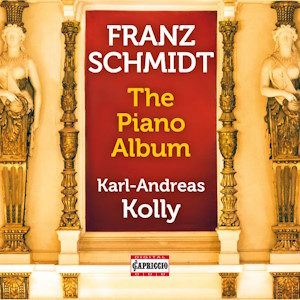
Franz Schmidt (1874-1939)
The Piano Album
Chaconne (1925)
Romanze (1922)
Toccata (1938)
Four Little Choral Preludes, No. 3 (1926)
Variations and Fugue on an Original Theme (1916, rev. 1924)
Karl-Andreas Kolly (piano)
Transcriptions for piano by Karl-Andreas Kolly
rec. 2022/23, Ehrbal Saal, Vienna, Austria
Capriccio C5526 [58]
“The Piano Album” is a trifle misleading title. Franz Schmidt only wrote the Romanze and the Toccata for solo piano, which together last less than twelve minutes. The other three works here are Karl-Andreas Kolly’s transcriptions of organ works. Kolly tells us that he loves the music, and that he hopes to give it a larger audience in the piano versions. His Schmidt credentials go back at least a far as the 1990s, when he recorded two big works for piano and orchestra, the Concerto and the Concert Variations on a theme of Beethoven.
I am indebted to Vol. 1 of Harold Truscott’s lamentably unfinished survey of Schmidt’s music for information on the two piano pieces. The Romanze presents various aspects of his style at a transitional stage in his compositional career. It is also one of his more personal works. He wrote the Romanze for his English friends Douglas and Molly Sephton, specifically for Molly’s dance recitals. She did not like the piece, so that is probably why Schmidt dedicated it to Douglas. As Truscott points out, the piece is not really dance music. Its interest lies in the foreshadowing of the large chamber and orchestral works Schmidt wrote later in the 1920s.
Except for the Romanze, all of Schmidt’s music for the piano was written for the one-armed pianist Paul Wittgenstein. The Toccata is the last of this group of six works, and (along with Schmidt’s third quintet) his last completed composition. It shows a fascinating new side of his musical personality: it is continuous in its forward motion.
The little Chorale Prelude on “O wie selig seid ihr doch, ihr Frommen” is as appealing on the piano as in its original form.
We now come to the transcriptions of the Chaconne and the Variations and Fugue, both among Schmidt’s largest organ works. In 1916, he began work on his second opera, Fredegundis. At the same time, he started writing an organ piece, his first for the instrument, based on fanfares from the opera. (This is like Taneyev’s Oresteia and the symphonic poem he based on the opera.) Schmidt revised the organ work, the Variations and Fugue, eight years later, and then produced a version for brass alone, and another version for organ, fourteen trumpets and kettledrum. Kolly gives us a piano version, in which he ably brings out the great imagination shown in the Variations, even if the piano cannot match the grandeur of the organ. It is unfortunate that Schmidt’s fine fugue is less convincing in piano garb.
Harold Truscott prefers the orchestral version of the Chaconne, and I tend to agree. But either way it is one of Schmidt’s most completely integrated works, and one of his finest. The Chaconne transfers well to the piano too. This brings out the Baroque elements of the score, perhaps more so than Schmidt might have approved of. There is also an increased clarity somewhat lacking in the other two versions.
I wrote earlier about Karl-Andreas Kolly’s love for Schmidt’s music, and it naturally is present in every piece here. What is also evident is Kolly’s great technical ability, and especially the depth of his musical thought. The performances are well supported by the quality of the engineering and the acoustics in the Ehrbar Saal in Vienna. This disc is sure to make new friends for Schmidt’s music.
William Kreindler
Buying this recording via a link below generates revenue for MWI and helps us keep free access to the site


















